
Shravanabelagola is a town located near Channarayapatna of Hassan district in the Indian state of Karnataka and is 144 km (89 mi) from Bengaluru. The Gommateshwara Bahubali statue at Shravanabelagola is one of the most important tirthas in Jainism, one that reached a peak in architectural and sculptural activity under the patronage of Western Ganga dynasty of Talakad. Chandragupta Maurya is said to have died here in 298 BCE after he became a Jain monk and assumed an ascetic life style.

Alwar is a city located in India's National Capital Region and the administrative headquarters of Alwar District in the state of Rajasthan. It is located 150 km south of Delhi and 150 km north of Jaipur. At present the district is famous for production of Mustard Crop in the region, manufacturing of Ray Ban eyeglasses, Beer production plants and frozen food industry.

Vidisha is a city in central Madhya Pradesh, India. It is located 62.5 km northeast of the state capital, Bhopal. The name "Vidisha" is derived from the nearby river "Bais", mentioned in the Puranas.

Chanderi, is a town of historical importance in Ashoknagar District of the state Madhya Pradesh in India. It is situated at a distance of 127 km from Shivpuri, 37 km from Lalitpur, 55 km from Ashok Nagar and about 46 km from Isagarh. It is surrounded by hills southwest of the Betwa River. Chanderi is surrounded by hills, lakes and forests and is spotted with several monuments of the Bundela Rajputs and Malwa sultans. It is famous for ancient Jain Temples. Its population in 2011 was 33,081.

Kumbhalgarh, also known as the Great Wall of India, is a Mewar fortress on the westerly range of Aravalli Hills, just about 48 km from Rajsamand city in the Rajsamand district of the Rajasthan state in western India. It is located about 84 km from Udaipur. It is a World Heritage Site included in Hill Forts of Rajasthan. It was built during the 15th century by Rana Kumbha.
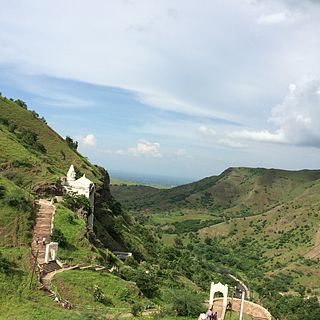
Bawangaja is a famous Jain pilgrim center in the Barwani district of southwestern Madhya Pradesh in India. Located about 6 kilometers south of River Narmada, its main attraction is the world's second largest megalithic statue of Lord Rishabhadeva, the first Jain Tirthankara. The statue is 84 feet (26 m) high. The center is located in the Satpura Range and is about 8 km from a Barwani town.

Rajasthan, a state in western India, has had a close historical connection with Jainism. Southwestern Rajasthan was the main centre for Svetambara Jainism. Major Digambara centres are in the northern and eastern parts of Rajasthan. Central and Northern Rajasthan are the main centres for the Terapanth sect of Svetambara Jainism.

Bijoliya is a census town in Bhilwara district in the state of Rajasthan, India and is surrounded by nature and waterfalls and is famous for Tapodaya Teerth Kshetra and Mandakini Temple.
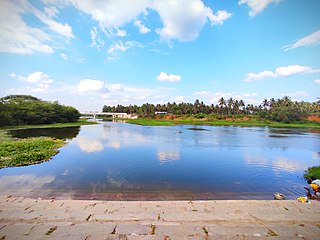
Maddur is a town in Mandya district in the Indian state of Karnataka. It lies on the banks of the river Shimsha. It is 82 kilometers from the state capital Bangalore and 60 kilometers from Mysore. Derived from Maddu a term referring to chemicals used for explosives. According to a Tamil inscription found in Ugra Narasimha temple, the town was called Marudhur during the Hoysala period, from which the name Maddur might have been derived.

Śhāntinātha or Śhānti is the sixteenth Tīrthaṅkara of Jainism in the present age. According to traditional accounts, he was born to King Vishvasena and Queen Aćira of the Ikshvaku dynasty in the north Indian city of Hastinapur. His birth date is the thirteenth day of the Jyest Krishna month of the Indian calendar. He was also a Chakravartin and a Kamadeva. He ascended to the throne when he was 25 years old. After over 25,000 years on the throne, he became a Jain monk and started his penance.
Bahuriband, near Katni in Madhya Pradesh, is a famous inscription at the feet of a colossal stone image of Jain Tirthankara Shantinath. The colossal statue is 12 ft 2 in (3.71 m) in height.

Rajasthan is one of the most popular tourist destinations in India, for both domestic and international tourists. Rajasthan attracts tourists for its historical forts, palaces, art and culture with its slogan "Padharo Mhare Desh". Jaipur, is also known as Pink City, is a very popular tourist destination, being the capital of Rajasthan and a part of the Golden Triangle. The Walled City of Jaipur is a UNESCO World Heritage Site and is only the second Indian city to be recognized, after Ahmedabad.
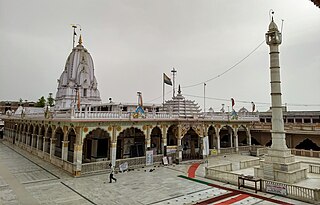
Tijara Jain Temple is a digambar Jain temple dedicated to Chandraprabha. The temple is located in the hill town Tijara, in the Alwar district of Rajasthan, India. It is an Atishaya Kshetra. It is 55 kilometres (34 mi) from Alwar and 110 kilometres (68 mi) from Delhi. The location is a tirtha for the Jains and a tourist attraction.
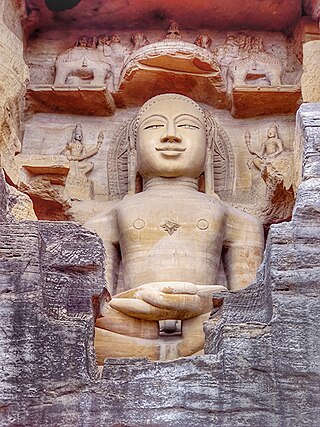
The Gopachal rock-cut Jain monuments, also called Gopachal Parvat Jaina monuments, are a group of Jain rock-cut carvings dated to between the 7th and 15th centuries. They are located around the walls of the Gwalior Fort, Madhya Pradesh. They depict Tirthankaras in seated Padmasana posture as well as standing Kayotsarga posture, in the typical naked form of Jain iconography.

Bhandasar Jain Temple or Bhanda Shah Jain temple, is a Jain temple located in Bikaner, Rajasthan. The temple is famous for wall painting and art work. This temple is protected by the Archaeological Survey of India.
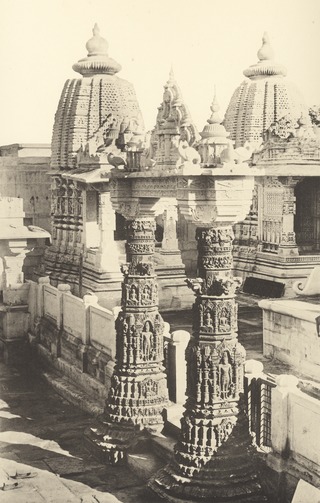
The Mahavira Jain temple is built in Osian of Jodhpur District, Rajasthan. The temple is an important pilgrimage of the Oswal Jain community. This temple is the oldest surviving Jain temple in Western India and was built during the reign of Mahārāja Śrī Vatsarāja of Imperial Pratihāras. The temple is visited by both Jain and Hindu.

The Samadhishvara Temple is a Hindu temple located in the Chittor Fort in Rajasthan, India. It is dedicated to Shiva, who is called "Samadhishvara", that is, "Lord of Samadhi". Epigraphic evidence suggests that the temple was constructed in the 11th century, and was further restored in the 13th and the 15th centuries.
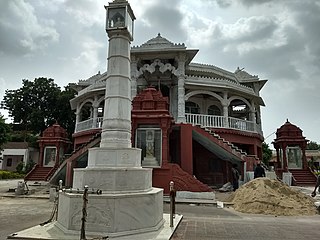
Bijolia Parshvanath Temple or Tapodaya Teerth Kshetra is a Jain pilgrimage center located in Bijolia town in Bhilwara district of Rajasthan.

Chamatkarji is an important Jain temple located near Ranthambore Fort in the city of Sawai Madhopur in Rajasthan.





















